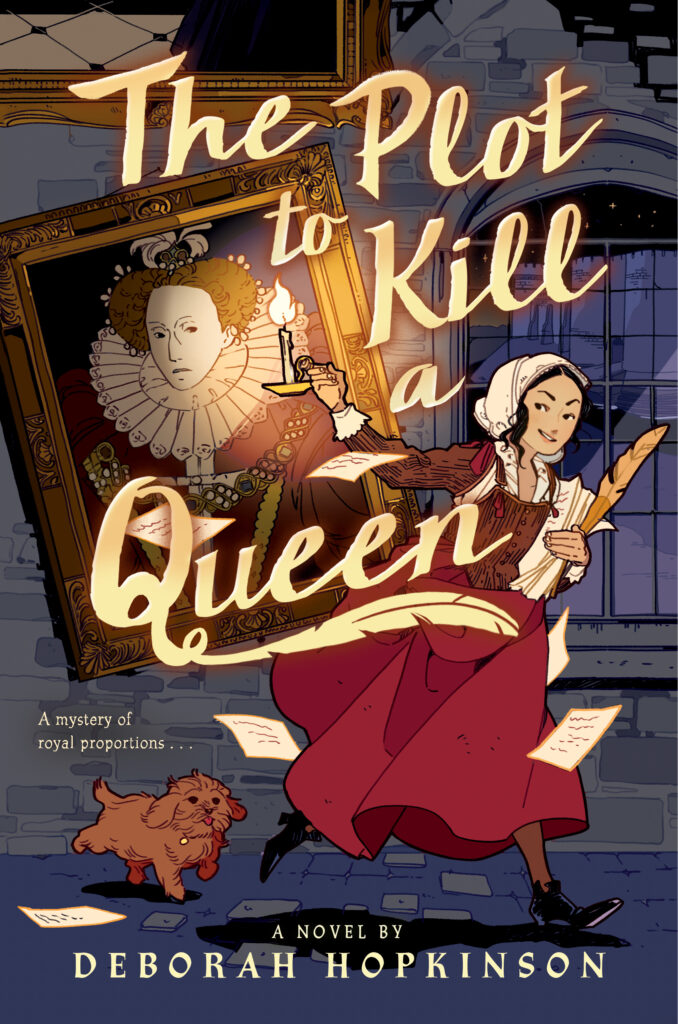All the World’s a Stage: Making Theater (and History) Fun for Teens, a guest post by Deborah Hopkinson

What’s more fun than theater? There’s a role for just about everyone, whether it’s performing, painting sets, making props, playing music, or being a stagehand. By its very nature, theater is collaborative, encouraging teamwork and community. And if you’ve kept up with recent news about the challenges facing live theater in the US, you know that to survive, American theaters will need young people who grow up to value and support the arts.
Although I’d love to inspire a lifelong appreciation of theater in tweens and teens, while also encouraging young playwrights, that’s not why I wrote The Plot to Kill a Queen (Scholastic 2023).
ADVERTISEMENT
ADVERTISEMENT
Instead, I got the idea in the usual way—mostly by accident. As I tell students at author visits, I get ideas the same way they do: from personal experience, things I watch or read, and from my interests and passions. That’s what happened when I stumbled across an article about an early female British writer named Emilia Bassano (1569-1645) and her possible connection to Shakespeare (though most scholars conclude it’s unlikely).
Nevertheless, one fun aspect of historical fiction as opposed to nonfiction (which I also write) is that fiction allows the freedom to speculate: What if Emilia and Shakespeare did meet? What then?
I also was eager to learn more about Emilia Bassano, whose name was new to me. My fascination grew as I researched: How did the daughter of an Italian-born musician who never married Emilia’s English mother end up writing a book? There’s much we don’t know about the real Emilia, including whether the Bassano family may have been of Jewish heritage and conversos, secret converts to escape persecution. But the fact remains that in 1611 Emilia wrote a book of poetry that she dedicated to prominent women, perhaps seeking a patron. She clearly saw herself as an author.
My version of Emilia is a wonderer. I myself first started wondering about the history of women writers as a lonely, awkward middle schooler. I read Austen and Brontё and dreamed of being an author. I studied literature in college, including the female writers of the Heian period in Japan. I’ve written a picture book on Jane Austen and in Fatal Throne: The Wives of Henry VIII Tell All (a fun collaborative writing project), I penned the voice of Katherine Parr, Henry VIII’s sixth wife. In 1545, Parr published a book under her own name. She was also Elizabeth’s (final) stepmother.
Plot is set in 1582, when Elizabeth was on the throne and her cousin, Mary Queen of Scots, was being held captive in England. The real Emilia was thirteen that fall; eighteen-year-old Will Shakespeare was just about to be married to Anne Hathaway.
In my novel, Emilia is a lute player like her father, as well as an aspiring author. She’s friends with Horace, a palace apprentice cook, and serves as companion to Frances Walsingham, daughter of the queen’s spymaster—her benefactor since her father’s death. Emilia wants to enter a competition to write a play to be performed during the holidays at court. (A fascinating footnote: The Folger Shakespeare Library includes a day-to-day chronology of life in the Elizabeth court, including the name of a play performed at court in December of 1582. How cool is that?)
Will Shakespeare gets a short but significant cameo appearance in Plot when he meets a disguised Emilia and her dog, Mouse, at an inn courtyard playhouse. (As an aside, this is my spaniel Rue’s second appearance in fiction. She played Little Roo in How I Became a Spy. And yes, she is named for that Rue.)
Speaking of asides, I love to play with structure in fiction. In Plot (which includes Elizabethan illustrations and delightful design elements), Emilia is writing her play at Sheffield Castle, where her guardian has sent her on a mission to play the lute for Mary and try to uncover more about Mary’s secret plot on Elizabeth’s life. So it seemed fitting to tell the story as a three-act play.
And to make it more fun (and, I hope, useful for educators and students alike) I’ve also included definitions of theatrical terms throughout. The table of contents for Plot is called the playbill; there are two intervals, or intermissions. Emilia has a soliloquy. The production notes (back matter) provides information on the queens’ deadly rivalry, Elizabethan theater, and Shakespeare, including mention of the first Black and female Shakespearean actors.
And, of course, Plot includes Emilia’s play. There has to be a play!
Thanks to Will Shakespeare’s suggestion that Emilia write about history (something he, of course, later did in real life), Emilia writes The Princess Saves the Cakes, a girl-power version of an old English tale about King Alfred burning some cakes baking on the fire of a hut while he and his followers were fleeing the Vikings. The play appears as an appendix in the book, and is free for classes to perform. In Emilia’s version, King Alfred’s eldest daughter, Aethelflaed, who later ruled the region of Mercia, takes a leading role.
History is full of contradictions—contradictions Emilia can’t help but wonder about. Queen Elizabeth ruled decisively, but only men with white skin were allowed to act on stage. Elizabeth was patron of Gray’s Inn, but women couldn’t practice law in England until the twentieth century.
There is no time travel in Plot, except in Emilia’s questioning spirit as she looks back to Aethelflaed’s time, and wonders what life will be like hundreds of years in the future. And here we are in that future, grappling with the contradictions of our own time.
Although it’s set in 1582, Plot is probably my most personal book. I’ve never been on stage, except for a middle school readers’ theater adaption of A Christmas Carol. But one of my first jobs was as marketing director for a community theater in Honolulu.
My daughter, Rebekah, was born during my tenure there, and perhaps that’s why she picked up the theater bug. (My son was in summer musicals as well.) Rebekah appeared in leading roles in high school and community theater productions, and now mounts plays with her students as a Waldorf teacher in Vermont.
As an added bonus, during a recent visit here to Oregon, Rebekah joined me to record the “production notes” in the audiobook version of the novel. (Wait until you hear narrator Rosie Jones!) Rebekah also voiced the narrator in The Princess Saves the Cakes.
Finally, as in all my books, in Plot I try to encourage young people to tell their own stories. In the prologue, Emilia urges readers to do just that. “Of course, we can’t all be Shakespeare. That doesn’t mean our stories don’t count. In fact, I believe our stories matter more, because honestly, if we don’t tell them, who will?”
And so I hope you and young readers you know will pick up The Plot to Kill a Queen, and experience, in just a small way, the magic of theater. As Emilia advises at the start, “Imagine you’re entering a playhouse. Found a good spot? Excellent. Settle in, then turn the page. Glance at the playbill to see who’s who and what’s ahead.”
“But don’t tarry too long: The curtain is about to rise.”
Meet the author

ADVERTISEMENT
ADVERTISEMENT
Deborah Hopkinson is the award-winning author of more than 70 books for young readers including picture books, middle grade historical fiction, Little Golden Book biographies, and long form nonfiction. Other awards include a Sibert honor, a Carter G. Woodson honor, NCTE Orbis Pictus Honor, and Boston Globe/Horn Book honor. Deborah received a B.A. and a master’s degree from the University of Hawai’i at Mānoa and worked in academic advancement prior to writing full time. Deborah currently lives in Oregon. Follow her on Twitter @deborahopkinson, Instagram @deborah_hopkinson, or online at www.deborahhopkinson.com.
Links
Twitter: @Deborahopkinson
Instagram: @Deborah_Hopkinson
About The Plot to Kill a Queen
From award-winning author Deborah Hopkinson comes an utterly charming, deftly crafted mystery about an intrepid young girl’s quest to foil a plot to assassinate Queen Elizabeth I.
Emilia Bassano is a girl who relishes the music of words. Although she plays the lute and writes poetry, Emilia nurtures a dream: to hear her words come alive on stage. Emilia wants to write soliloquies for heroes and kings and queens of old, fashion fierce villains to make audiences howl, and try her hand at comedy and romance. Most of all, she wants to create unforgettable women characters.
On one of her trips to the theater, an unfortunate series of events leaves her penniless, with no way of watching the show. That is until a boy by the name of Will Shakespeare helps her sneak in to see the play. They realize they’re both aspiring playwrights and Emilia convinces Will to join her in her efforts to win a playwriting competition at the palace of Queen Elizabeth I.
However, when Emilia accidentally uncovers a plot to kill the queen, she is given the job of traveling to the castle where Mary Queen of Scots is being held captive, to discover who is responsible for the plan to murder Queen Elizabeth—and to thwart it! Can Emilia and her friends stop the plans of a disguised murderer on the loose?
This delightful mystery is a marvel of incisive wit and extraordinary craft from the beloved, award-winning author Deborah Hopkinson.
ISBN-13: 9781338660586
Publisher: Scholastic, Inc.
Publication date: 10/17/2023
Age Range: 8 – 12 Years
Filed under: Guest Post
About Amanda MacGregor
Amanda MacGregor works in an elementary library, loves dogs, and can be found on BlueSky at @amandamacgregor.bsky.social.
ADVERTISEMENT
ADVERTISEMENT
SLJ Blog Network
Now on The Yarn: Colby’s Alaskan Children’s Book Adventure
Publisher Preview: Transit Editions (Winter 2025/26)
Exclusive: Archie Unveils New Graphic Novel Slate for Fall 2025 | News
When Book Bans are a Form of Discrimination, What is the Path to Justice?
ADVERTISEMENT







